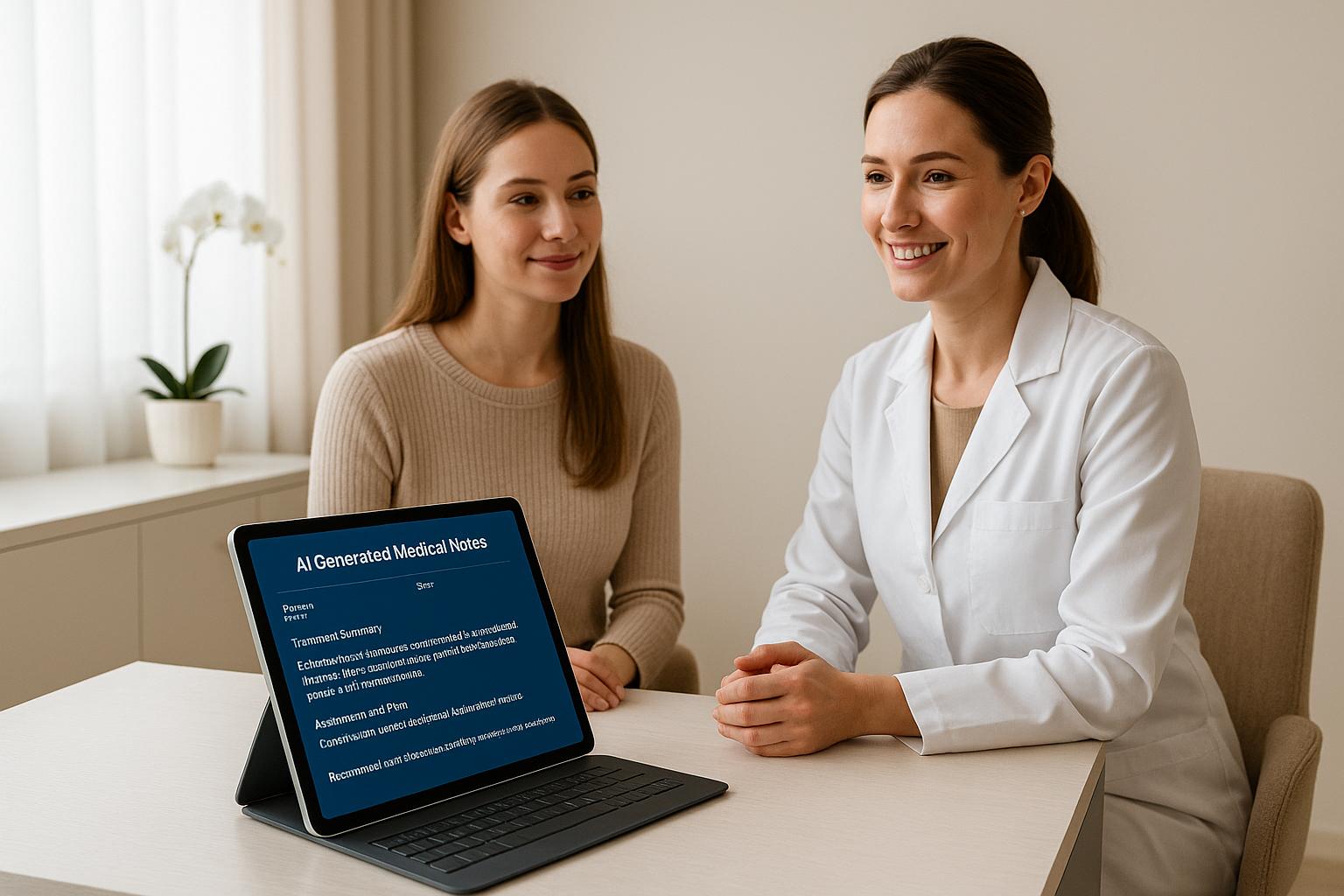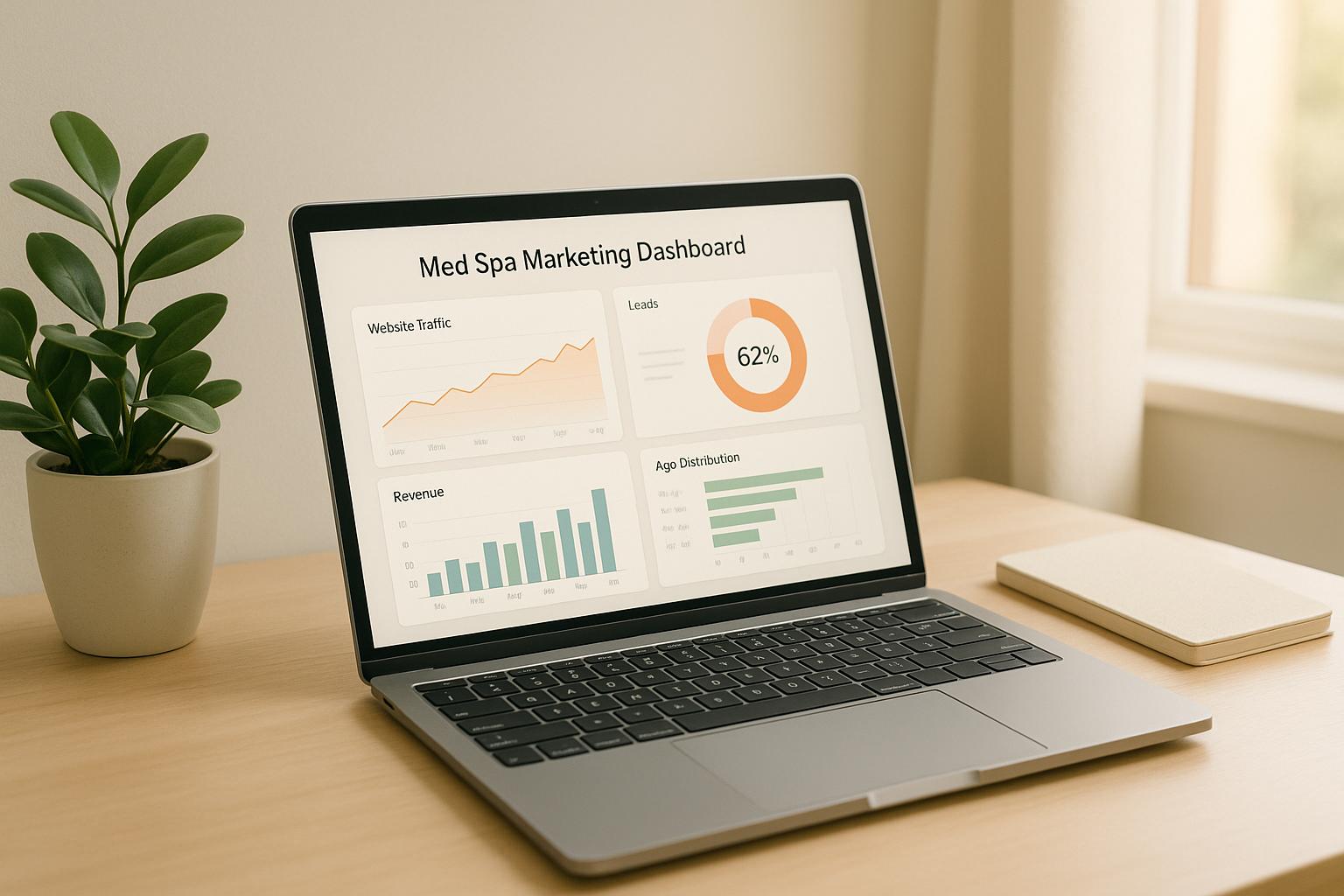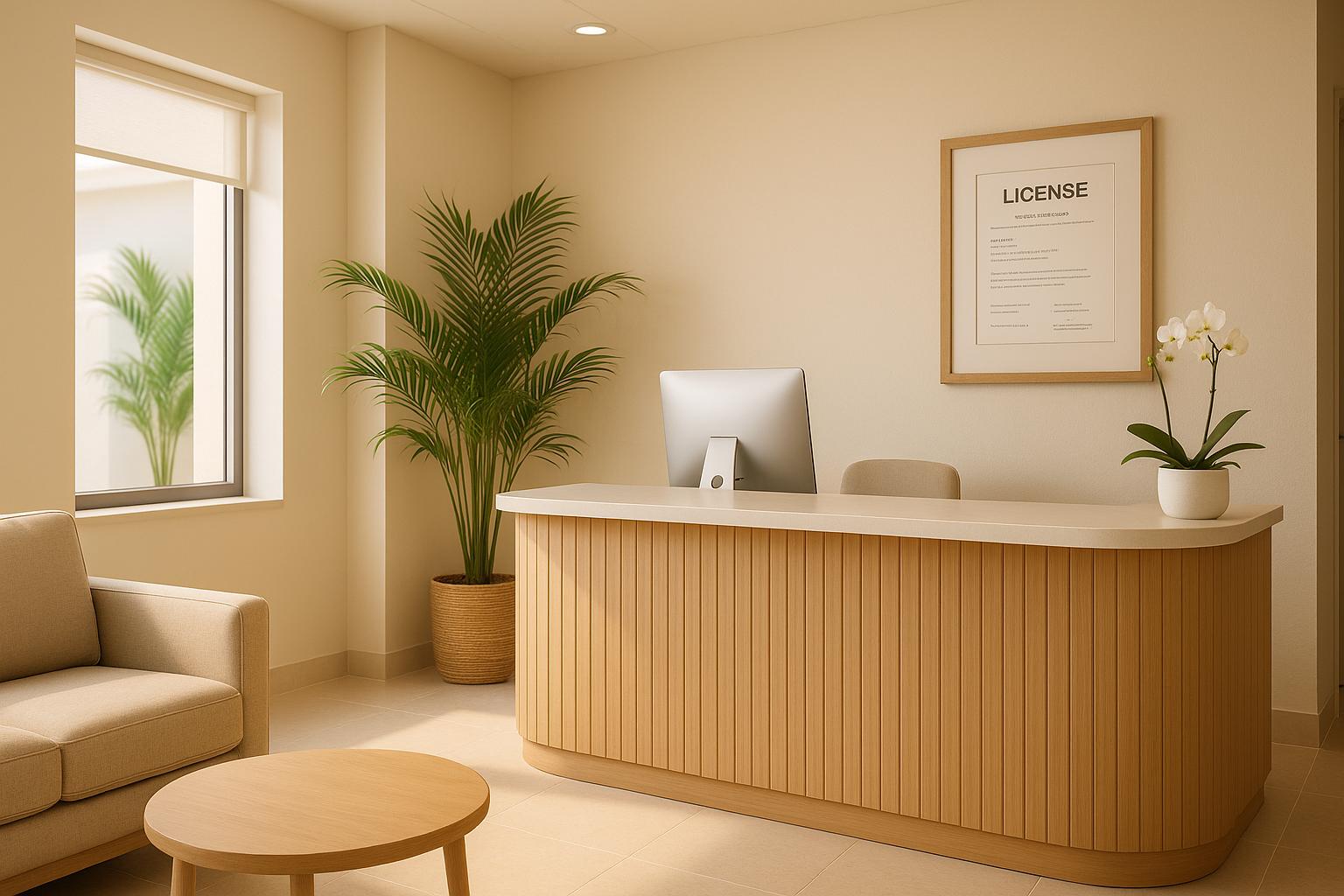AI note creation is transforming how aesthetic clinics handle documentation. Using speech recognition and natural language processing (NLP), these tools turn conversations into structured clinical notes in real time. This eliminates manual note-taking, allowing providers to focus entirely on patients while ensuring accurate records for treatments like Botox, dermal fillers, and laser procedures.
Here’s why this matters:
- Saves time: Automates transcription and integrates with electronic health records (EHRs).
- Improves accuracy: Captures detailed treatment histories, including dosages and injection sites.
- Enhances patient care: Providers can engage fully with patients without distractions.
- Supports compliance: Meets HIPAA standards to safeguard sensitive patient data.
Platforms like Prospyr go further by integrating AI note creation with scheduling, billing, and patient management, streamlining clinic operations while maintaining high documentation standards. This technology is reshaping clinical efficiency and patient care in aesthetic practices.
How AI Note Creation Works
The AI Note Creation Process
AI note creation turns patient consultations into structured clinical documentation through a straightforward, four-step process. First, it captures the real-time audio of the consultation using speech recognition technology. Then, natural language processing (NLP) extracts and contextualizes key medical details from the conversation.
Next, the system organizes this information into structured formats, such as SOAP notes, treatment summaries, or consultation records, ensuring the documentation aligns with clinical standards. This is particularly important for cosmetic treatments, where accuracy is essential. Finally, the system generates a fully formatted clinical note that integrates seamlessly into the practice's electronic health record (EHR) system. This streamlined process helps support personalized treatment plans in aesthetic practices.
Integration with Specialty-Specific Templates
Specialty-specific templates are a cornerstone of effective AI note creation, offering a clear framework for extracting and formatting information tailored to aesthetic practices. These templates remove ambiguity by providing structured guidelines, ensuring thorough and consistent documentation.
Some AI systems can transform existing sample notes into reusable templates that align with aesthetic medicine workflows. These templates can be customized to match the practice’s preferred structure, style, and language. Dynamic placeholders built into the templates automatically populate with relevant details during the note creation process.
Advanced templates go a step further, featuring tools to accurately document skin observations and produce detailed visit notes that include both clinical assessments and aesthetic treatment plans.
These templates support various types of documentation critical to aesthetic practices, such as patient intake summaries, consultation notes, treatment records, and after-visit summaries. AI systems adapt to the specific instructions for each template type, ensuring consistent formatting and meeting the unique requirements of aesthetic medicine. Alongside their functionality, these templates are designed with robust data security in mind.
HIPAA Compliance and Data Privacy
Once documentation is structured, protecting patient data becomes a top priority for any AI note creation system used in aesthetic clinics. These platforms must meet strict HIPAA standards to ensure the security of patient information throughout the process.
HIPAA-compliant systems implement several safeguards, such as encrypting data during transit and storage, using strict access controls, and maintaining audit trails that log all interactions with patient data. These measures ensure full compliance with privacy regulations.
A key feature of compliant systems is that they process patient data within controlled environments, avoiding third-party services. This ensures that patient conversations and notes remain securely within the clinic’s digital ecosystem.
For aesthetic clinics, this protection is especially crucial, as patients often share personal details about their appearance and cosmetic goals. Proper data security ensures that this sensitive information is treated with the same care as any other medical record.
Before adopting an AI note creation system, clinics should verify the platform’s HIPAA compliance certification and understand how it handles patient data. This includes reviewing policies on data retention, confirming storage locations, and ensuring staff are trained to maintain compliance when using these tools.
Benefits of AI Note Creation for Aesthetic Clinics
AI-powered tools are transforming clinical documentation, bringing advantages that boost efficiency and elevate patient care.
Time Savings and Reduced Administrative Work
AI note creation dramatically cuts down the time spent on documentation. By automating tasks like recording, transcribing, and summarizing, providers can shift their focus entirely to patients.
These systems can capture conversations during consultations, transcribe them in real time, and automatically generate structured clinical notes. For aesthetic clinics handling numerous procedures each day, this reduces administrative tasks and simplifies workflows.
When integrated with practice management systems, AI tools take this efficiency even further. Automatically syncing notes with electronic health records eliminates the need for duplicate data entry. This allows staff to focus on essential tasks like booking appointments, sending reminders, and addressing patient inquiries. The seamless connection between clinical and administrative systems ensures smoother operations overall.
Improved Accuracy and Documentation Quality
AI tools enhance the quality of clinical documentation by leveraging advanced speech recognition and natural language processing (NLP). Patient concerns and treatment plans are captured with precision, ensuring consistent and accurate records. This standardization doesn’t just simplify record-keeping; it also makes clinical reviews clearer, helps meet regulatory requirements, and supports better patient care by providing detailed, easy-to-access treatment histories.
More Patient-Focused Care
By removing the need for manual note-taking, AI allows providers to fully engage with patients during consultations. With their attention undivided, clinicians can have more meaningful conversations, explain procedures in depth, and address patient concerns thoroughly.
Additionally, the time saved enables providers to review detailed patient histories more efficiently, ensuring personalized care. When multiple providers are involved, comprehensive and searchable documentation from previous visits ensures continuity, making patients feel seen and valued at every step of their journey.
Integrating AI Note Creation into Practice Management
AI note creation becomes most effective when seamlessly tied to your practice management system, linking essential functions like scheduling, patient records, billing, and communication.
Integration with Practice Management Platforms
Aesthetic clinics thrive on platforms that bring together scheduling, patient records, billing, and communication in one place. When AI note creation is integrated into these systems, it eliminates isolated data and reduces the need to juggle multiple applications.
Here’s how it works: AI-generated notes automatically sync with electronic medical records (EMR) and customer relationship management (CRM) systems. After a consultation, the AI-transcribed notes are added to the patient’s file, update treatment histories, and even initiate follow-up actions like appointment reminders or post-care instructions.
This streamlined data connection creates a more unified and efficient patient journey.
Unified Workflow for Aesthetic Clinics
A unified workflow ensures every step of a patient’s journey is connected: data from online scheduling flows into the system, AI captures and organizes consultation details into structured notes, and follow-up actions like billing and communication are triggered automatically.
This approach minimizes duplicate data entry and reduces the chance of administrative errors. For example, task management tools can create actionable items based on consultation notes. If a provider mentions scheduling a follow-up in six weeks, the system can automatically assign a task for staff to contact the patient at the right time.
By simplifying administrative tasks, clinics can focus on enhancing patient care - a key advantage of AI-driven documentation.
Prospyr's AI Note Creation Features

Prospyr showcases how a unified system can boost practice efficiency through AI integration.
This platform combines AI note creation with scheduling, EMR/CRM updates, and automated communication. Consultations are transcribed into HIPAA-compliant notes that seamlessly merge with patient records. Digital intake forms pre-fill essential details, saving time on documentation. Automated email and SMS follow-ups can send educational content or special offers tailored to the consultation. Integrated payment processing ensures billing aligns with discussed procedures, while review management tools prompt patients for feedback after treatments.
Prospyr also includes practice analytics, offering insights pulled from AI-generated documentation. Clinic owners can track treatment trends, patient preferences, and provider performance. These insights support better business decisions while maintaining the detailed documentation required for quality care and compliance.
sbb-itb-02f5876
Best Practices for Implementing AI Note Creation
Once you've added AI note creation to your management system, following some best practices can help you get the most out of it. These steps ensure efficiency, accuracy, and a patient-centered approach, all while maintaining the high standards your practice demands.
Getting Patient Consent and Maintaining Transparency
It's important to clearly explain to patients how consultations will be recorded, transcribed, and processed by AI. Use straightforward language and make sure your consent process includes both written and verbal components. The consent form should outline:
- What will be recorded and processed
- How the data will be stored
- Who will have access to the information
Patients often appreciate the accuracy and improved focus that AI note-taking brings to their care. For added reassurance, provide a verbal reminder before each consultation begins. A simple statement like, "This session will be recorded to help with note-taking", can go a long way in making patients feel comfortable and giving them a chance to ask questions.
Posting small signs in consultation rooms that mention AI-assisted documentation can also be helpful. These unobtrusive reminders reinforce transparency and can even highlight the benefits of AI, such as allowing providers to maintain better eye contact during discussions instead of typing notes.
Make sure all procedures comply with HIPAA standards. Let patients know their recorded consultations are encrypted and handled with the same level of security as traditional medical records. This clear communication builds trust and sets the stage for smooth implementation.
Training Staff on AI Tools and Review Processes
Transparency with patients is just the first step - your staff also needs to be well-prepared to use AI tools effectively. Provide targeted, hands-on training sessions using sample consultations to familiarize your team with the system.
Review protocols are essential for ensuring the accuracy of AI-generated notes. Train staff to double-check details like dosage amounts, product names, and treatment locations. For example, if the AI misses a specific concern a patient raised or skips over injection site details, staff should know how to quickly and accurately fill in the gaps.
Each team member's training should align with their role. Providers should focus on speaking clearly during consultations to help the AI capture information accurately. Administrative staff need to understand how to review, edit, and finalize notes. Front desk personnel should be equipped to explain the consent process and answer basic questions about the technology.
Once your team is comfortable with the system, you can move on to customizing templates to fit your practice's unique needs.
Customizing Prompts and Templates for Your Practice
Tailored templates and prompts are key to capturing the specific details of your practice's treatments. For aesthetic consultations, for example, you might include sections for injection sites, product names, and patient goals. Customizing the language to match your practice's terminology can significantly reduce the need for post-consultation edits.
For instance, a Botox consultation template could include fields for muscle movement assessments, units discussed, injection sites, and the expected timeline for results. Dermal filler consultations might focus on volume loss assessments, product choices, and post-treatment care instructions.
AI prompts should also reflect your practice's natural documentation style. Instead of relying on generic medical terms, train the system to use the language your providers typically use. This adjustment not only improves accuracy but also streamlines the review process.
You can create different prompt sets for various types of appointments. Initial consultations might require more comprehensive templates to capture medical history and treatment planning, while follow-up visits can use shorter templates that focus on outcomes and next steps.
Incorporating specialty-specific language into your AI system makes a big difference. Train it to recognize the brand names of products you use, the techniques your team employs, and the terminology your providers prefer. For example, if your practice uses specific injection methods or has unique ways of describing facial anatomy, include those details in your prompts.
Finally, make sure your customized templates integrate seamlessly with your existing workflow. Platforms like Prospyr allow you to create templates that automatically populate patient records and trigger follow-up actions based on the AI-captured consultation content. This integration ensures that your practice runs smoothly while leveraging the benefits of AI note creation.
Conclusion and Key Takeaways
AI-powered note creation is revolutionizing aesthetic clinics by addressing the challenges of manual documentation while prioritizing high-quality patient care.
How AI Benefits Aesthetic Clinics
The impact of AI note creation goes well beyond saving time. It ensures precise documentation of treatment details, allowing providers to dedicate more attention to their patients. This leads to better patient engagement and a more personalized experience.
By automating transcription, AI simplifies documentation, reduces administrative workloads, and streamlines clinic operations. For aesthetic practices, where detailed records of procedures, product usage, and patient outcomes are vital, these efficiency improvements are invaluable - not just for medical accuracy but also for business management.
Additionally, HIPAA-compliant integrations safeguard patient data while maintaining cohesive workflows. AI-generated notes also ensure comprehensive records, which are critical for consistent follow-ups and informed treatment planning. This is particularly important in aesthetic medicine, where treatments often involve multiple sessions and long-term patient relationships.
These features make AI an essential tool for modernizing and simplifying aesthetic practice management.
Why Consider Tools Like Prospyr?
To fully leverage these benefits, clinics can turn to platforms like Prospyr, which seamlessly integrates AI note creation with other essential tools. Prospyr combines transcription and note generation with scheduling, patient management, payment processing, and marketing automation - all within a single, HIPAA-compliant system.
Prospyr’s AI-powered notes are automatically added to patient records, triggering follow-up communications and supporting the clinic’s overall efficiency. This eliminates the need for juggling multiple software platforms, creating a unified workflow.
The platform also offers customizable templates and prompts tailored to aesthetic procedures. Whether documenting Botox treatments, dermal filler consultations, or comprehensive assessments, Prospyr’s system adapts to the specific terminology and documentation needs of your clinic. It’s a comprehensive solution designed to simplify operations and enhance patient care.
FAQs
How does AI-powered note creation improve clinical documentation in aesthetic clinics?
AI-driven tools for note creation are transforming clinical documentation by making it clearer and more accurate. These systems automatically organize and structure information, ensuring that records are both precise and easy to follow - critical for effective treatment planning and meeting legal requirements.
By simplifying the process, these tools save valuable time, lighten the workload for clinicians, and help reduce burnout. They also offer real-time error detection, ensuring records stay accurate while allowing healthcare professionals to dedicate more attention to their patients.
How can aesthetic clinics ensure HIPAA compliance when using AI tools for note creation?
To comply with HIPAA regulations, aesthetic clinics need to prioritize strong security measures like data encryption, access controls, and audit trails to safeguard patient information. Regular security audits and risk assessments are crucial for spotting and addressing any weaknesses in the system.
Using AI tools specifically built to meet HIPAA standards is another key step. These tools should emphasize data privacy and confidentiality. Collaborating with a platform that provides secure data storage and follows strict compliance protocols can protect sensitive patient information while simplifying clinic workflows.
How can aesthetic clinics personalize AI note templates to align with their procedures and workflows?
Aesthetic clinics have the flexibility to customize AI note templates to align with their specific treatments and day-to-day operations. By tweaking the format, style, and content, these templates can be made to fit the unique needs of the clinic, ensuring notes are precise and efficient while staying compliant with regulations.
For example, templates can be adjusted to incorporate details specific to certain procedures, use the clinic's preferred terminology, and meet any required documentation standards. This level of customization not only simplifies the workflow but also helps create a smoother, more personalized experience for patients.



